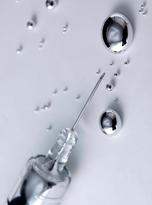https://www.nvic.org/faqs/mercury-thimerosal.aspx
FAQ's About Mercury (Thimerosal) in Vaccines
.jpg.aspx?width=152&height=205)
Q: Is it true that all the mercury has been removed from vaccines? How much mercury is in the flu shot and other recommended vaccines? Should I go out of my way to find a thimerosal-free flu shot and where can I find one?
- 0.5 parts per billion (ppb) mercury = Kills human neuroblastoma cells (Parran et al., Toxicol Sci 2005; 86: 132-140).
- 2 ppb mercury = U.S. EPA limit for drinking water.
- 20 ppb mercury = Neurite membrane structure destroyed (Leong et al., Neuroreport 2001; 12: 733-37).
- 200 ppb mercury = level in liquid the EPA classifies as hazardous waste.
- 25,000 ppb mercury = Concentration of mercury in the Hepatitis B vaccine, administered at birth in the U.S., from 1990-2001.
- 50,000 ppb Mercury = Concentration of mercury in multi-dose DTaP and Haemophilus B vaccine vials, administered 4 times each in the 1990's to children at 2, 4, 6, 12 and 18 months of age.
- 50,000 ppb Mercury = Current "preservative" level mercury in multi-dose flu (94% of supply), meningococcal and tetanus (7 and older) vaccines. This can be confirmed by simply analyzing the multi- dose vials.
Thimerosal in Vaccines
Thimerosal contains ethylmercury.
Thimerosal prevents the growth of bacteria in vaccines.
The human body eliminates thimerosal easily.
Thimerosal has been shown to be safe when used in vaccines.
There are some side effects of thimerosal in vaccines.
Scientific research does not show a connection between thimerosal and autism.
Thimerosal was taken out of childhood vaccines in the United States in 2001.
Levels in Different Species
Species
|
Mercury in ppm
|
Mercury (in mcg) per 3 ounces (85 grams)
|
Light tuna (canned)
|
0.126
|
10.71
|
Skipjack tuna (fresh or frozen)
|
0.144
|
12.24
|
Albacore tuna (canned)
|
0.350
|
29.75
|
Yellowfin tuna (fresh or frozen)
|
0.354
|
30.09
|
Albacore tuna (fresh or frozen)
|
0.358
|
30.43
|
Bigeye tuna (fresh or frozen)
|
0.689
|
58.57
|
Reference Doses and Safe Levels
Body weight
|
Reference dose per day (in mcg)
|
Reference dose per week (in mcg)
|
100 pounds (45 kg)
|
4.5
|
31.5
|
125 pounds (57 kg)
|
5.7
|
39.9
|
150 pounds (68 kg)
|
6.8
|
47.6
|
175 pounds (80 kg)
|
8.0
|
56.0
|
200 pounds (91 kg)
|
9.1
|
63.7
|



